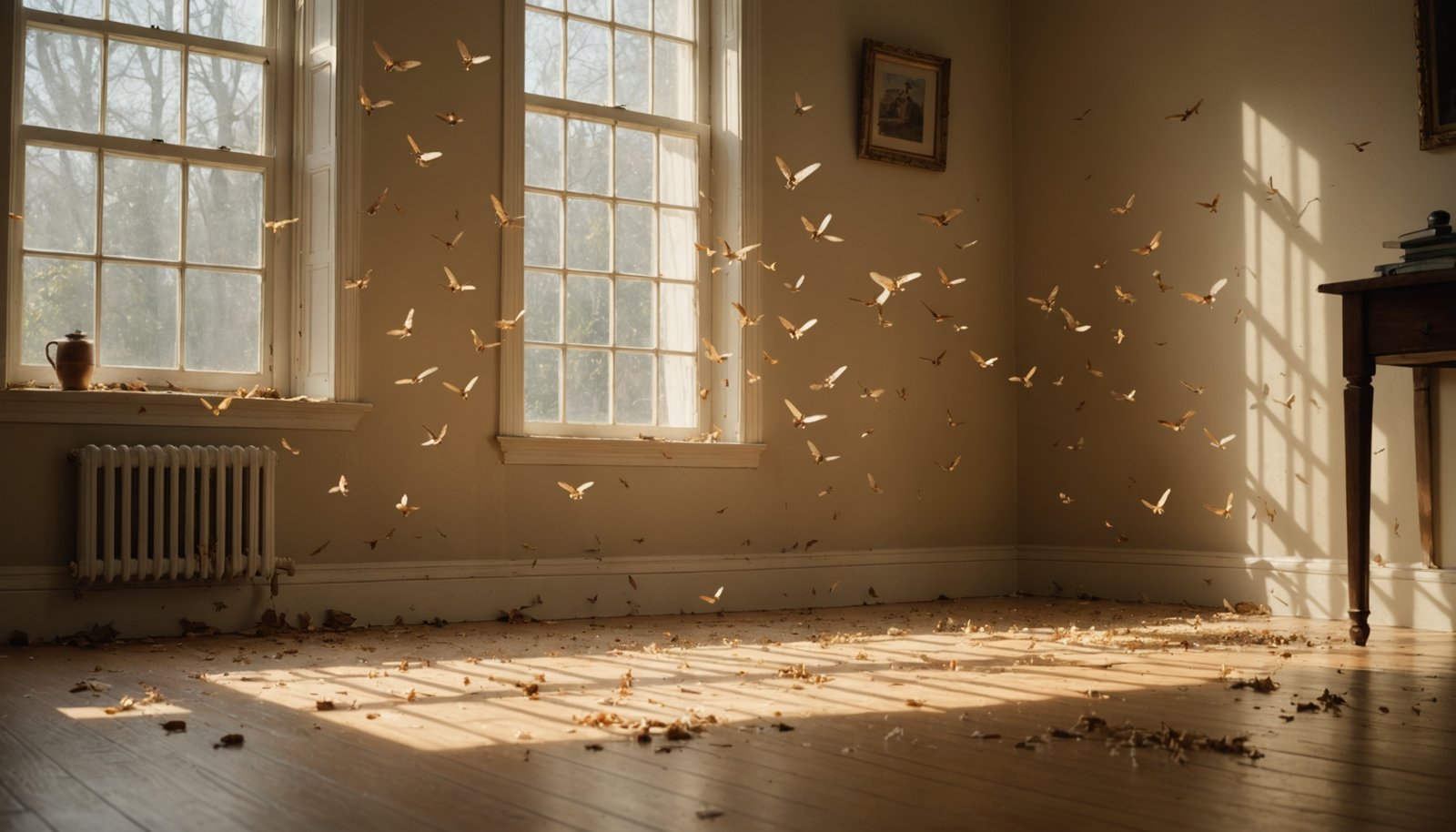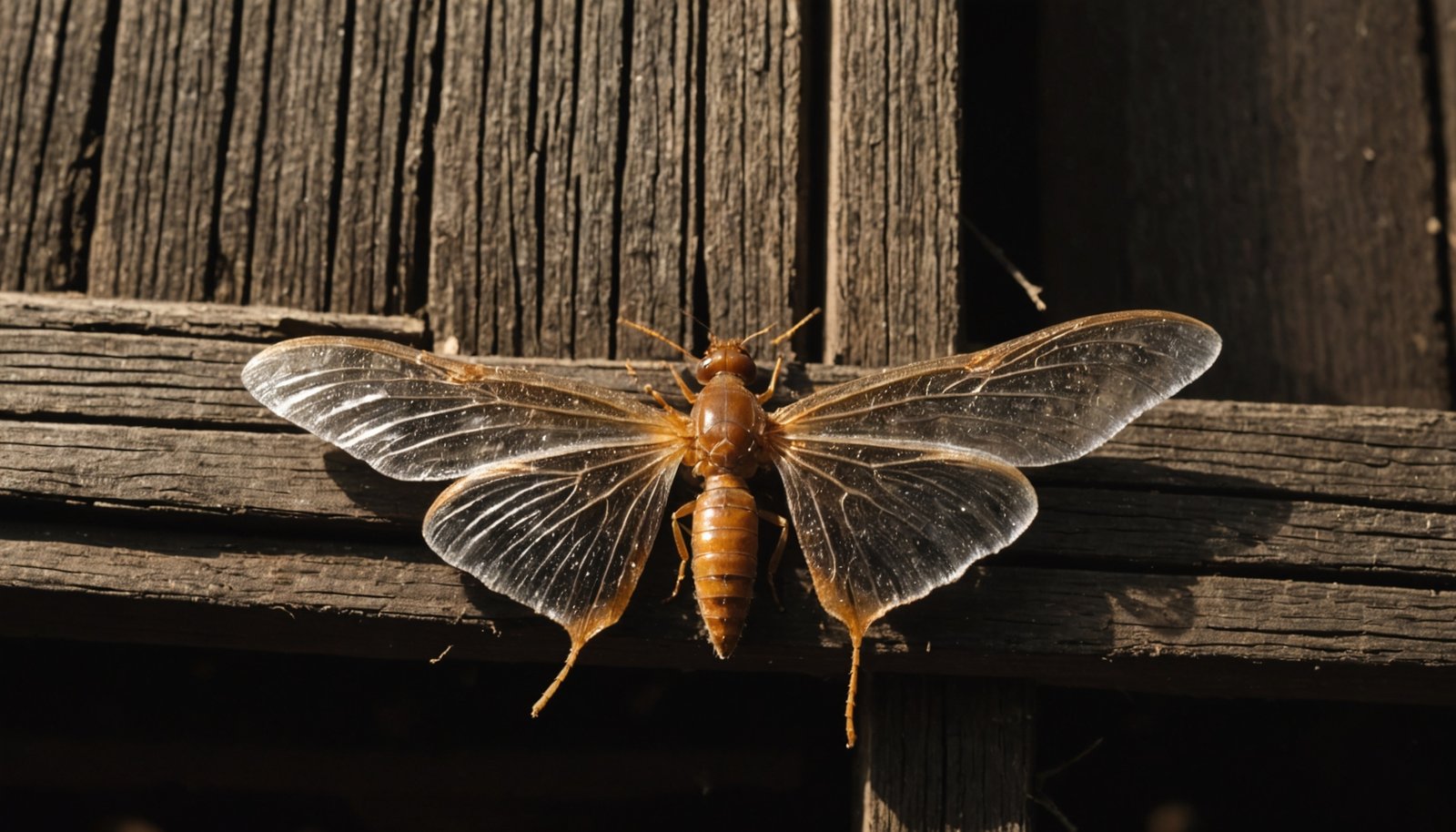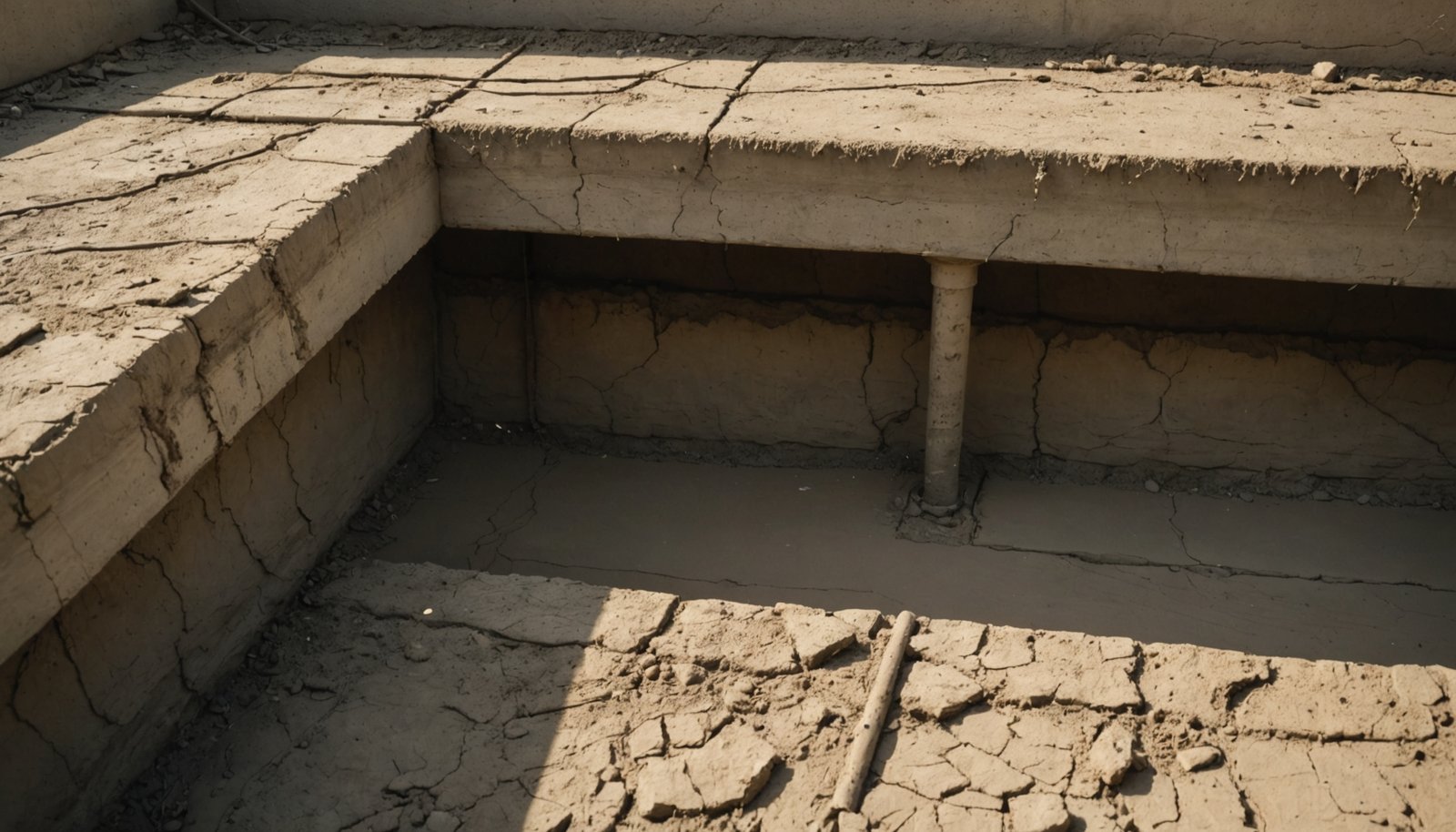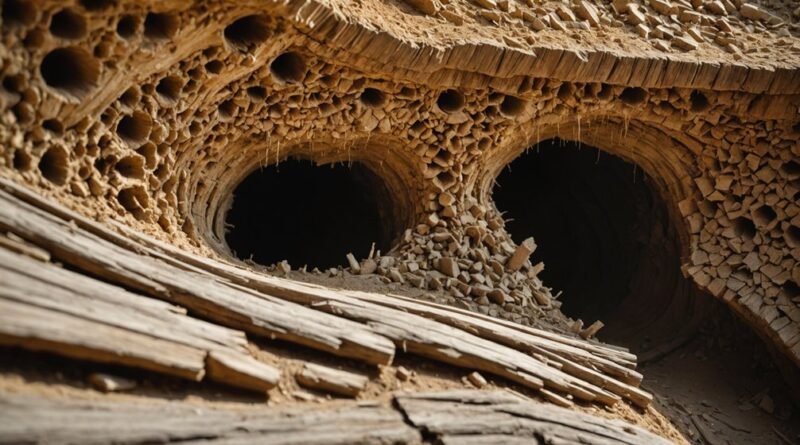Early Signs of a Termite Infestation Every Homeowner Should Know
Spot early termite trouble by watching for swarmers gathering at windows and lights, especially after warm, humid evenings. Look for piles of equal-sized discarded wings near doors or basements. Check foundations and crawl spaces for pencil-thin mud tubes. Sweep up any tiny frass pellets. Tap wood for hollow sounds or crumbling spots. Scan for small exit holes, maze-like tunneling, and bubbling or peeling paint without plumbing leaks. Reduce moisture and soil-to-wood contact. You’re about to see what else matters.
Key Takeaways
- Swarmers near windows or lights at dusk, and piles of equal-sized discarded wings, indicate termites emerged from within the home.
- Pencil-width mud tubes along foundations, thresholds, or crawl spaces signal subterranean termite travel routes.
- Wood that sounds hollow when tapped, or crumbles easily, suggests internal galleries from active feeding.
- Tiny pinholes, maze-like tunneling, or frass pellets on surfaces indicate drywood termite activity.
- Bubbling, peeling, or discolored paint and drywall without plumbing leaks may reflect moisture from hidden termite galleries.
Termite Swarmers Near Windows and Lights

Ever notice winged insects clustering at your windows or circling porch lights after dusk? You’re likely seeing termite swarmers, or alates. They’re drawn to bright, white light—porch lamps, motion lights, street lamps, and even light spilling from inside.
Strong lighting scrambles their navigation, so they fly toward windows, glass doors, and downlights, often resting on panes at night. Spotting swarmers near windows is a strong sign of a nearby or active colony. When they appear indoors, they likely emerged from within your structure and headed for the brightest exit, suggesting a mature colony feeding on your home. Termites are attracted to light, which is why swarmers frequently gather around porch lamps and windows during their swarming phase.
Bright lights draw swarmers to windows—often a warning of a mature, hidden colony nearby.
Their timing aligns with spring or warm, rainy evenings, especially at dusk when lights are on. Open or poorly sealed windows let them in.
Swarmers themselves don’t damage wood, but their presence signals workers are already doing it. Killing them at windows doesn’t solve the problem—prioritize a prompt professional inspection and targeted treatment.
Discarded Wings Around Doors and Basements

Spotting piles of translucent, equal-sized wings around door sills, window tracks, or basement steps usually means swarmers landed and a nearby colony is active.
Check corners, thresholds, window wells, and damp basement areas after warm, humid weather—especially in spring or fall. Early detection helps prevent extensive damage from termites.
If you find multiple clusters or see wings with mud tubes or soft wood, call a licensed pro promptly.
What Discarded Wings Mean
Although they can look like harmless debris, small piles of translucent, equal-sized wings around doors, windows, or basement thresholds are a classic red flag of termite swarmers. You’re seeing evidence that reproductive termites flew, paired off, and snapped off their wings to start new colonies.
Because this shedding happens in synchrony during warm, humid periods—often spring or fall—fresh wings indicate recent activity and a nearby nest. Contact professional pest control promptly, as winged termites indicate a mature colony and potential structural damage.
Termite wings are thin, veined, and come in two pairs of equal length, longer than the body. Don’t confuse them with flying ants, whose front wings are larger and antennae are bent; termites have straight antennae.
Finding these wings suggests a mature colony is present and capable of expansion. Act quickly: arrange a professional inspection and plan control measures to prevent structural damage.
Common Spots to Check
Fresh wing piles point you to where termites entered and swarmed: start with windows, doors, and the basement. Check windowsills and door frames for clusters of translucent wings that look like fish scales—swarmers chase light and shed them after mating. Test wooden frames for hollow sounds and note doors or windows that stick; swelling or weakened trim is common. Scan thresholds and nearby foundation walls for pencil-width mud tubes—dry, brown, fragile “highways.” In basements, focus on mudsills, joists, and subflooring, plus posts or steps set in concrete or soil. Warm spots near furnaces, heaters, and pipes attract activity in cold months. Eliminate soil-to-wood contact around entries; damp, ground-touching trim speeds infestations. Breaking open a mud tube may reveal active termites inside.
| Area | What to spot | Why it matters |
|---|---|---|
| Windows/Doors | Wing piles, mud tubes, sticking frames | Light draws swarmers; easy entry |
| Basements | Mud tubes, damaged timbers | Moisture and warmth sustain colonies |
| Ground contact | Soil-touching wood | Direct access accelerates infestation |
When to Call Pros
If you find piles of translucent, equal-length wings near doors, windows, or the basement, call a pro promptly—those shed wings mean swarmers recently entered and a mature colony may be nearby.
Don’t wait to spot live termites; discarded wings alone warrant an inspection. Swarms typically follow warm rains in spring or fall and occur in daylight, so wings appear soon after.
Pros can confirm activity by checking for mud tubes, hidden damage, and other evidence you might miss. Early treatment stops expansion and prevents expensive repairs. Swarmers are attracted to light, so you may notice wings clustered near bright windows or lamps.
Before calling, snap clear photos and note locations and dates.
Confirm they’re termite wings: two equal pairs extending past the body, delicate and shiny. If they’re near entry points, you likely have an active or nearby colony—act now.
Mud Tubes Along Foundations and Crawl Spaces

Mud tubes are the telltale highways of subterranean termites, often appearing as thin, dirt-colored lines along foundations and in crawl spaces. You’ll see pencil-width tunnels built from soil, wood particles, saliva, and feces. They keep termites humid and hidden while they move between underground nests and nearby wood.
Pencil-thin mud tubes reveal hidden subterranean termites, shielding their humid commute between nests and wood.
Tubes typically measure 1/4 to 1 inch wide and can run several feet along foundation walls, joists, and sill plates, even reaching window and door frames or under porches.
Look for thin, branching exploratory tubes that may be abandoned, and sturdier working tubes that handle heavy traffic. In crawl spaces, trace lines along beams and foundation walls, especially near damaged wood.
Bulging trim, peeling paint, or hollow-sounding wood near tubes often signals trouble. Fresh or repaired tubes indicate active colonies and warrant a professional inspection.
Remove old tubes completely after treatment to prevent confusion later. Missed tubes can lead to serious, hidden structural damage. Regularly inspect perimeters and basements.
Piles of Termite Droppings (Frass)
Granules on a windowsill can be more than dust—they’re likely termite droppings, known as frass. You’ll spot tiny, oval pellets about 1 millimeter long with six concave sides and rounded ends. They look like uniform capsules, not flaky like sawdust. Colors range from light beige to black, reflecting the wood termites are eating. Because drywood termites push waste out of kick-out holes, frass piles up beneath exit points.
Check windowsills, doorframes, baseboards, and floors below wooden furniture. If you see fresh, growing mounds, termites are actively feeding and maintaining hidden nests. Subterranean termites rarely leave visible droppings, so piles strongly suggest drywood activity.
| What to Look For | Why It Matters |
|---|---|
| Uniform, six-sided pellets | Distinguishes frass from sawdust |
| Piles beneath tiny holes | Indicates kick-out (waste) holes |
| Colors matching wood tones | Tied to consumed wood |
| Granular feel, loose mounds | Not fine or fluffy like sawdust |
| New pellets reappearing | Signals ongoing infestation |
Hollow-Sounding or Crumbling Wood
A hollow thud from a baseboard or doorframe is a classic termite red flag. Termites eat wood from the inside out, so surfaces look normal while the core is destroyed. Tap suspicious trim, studs, or floorboards with your knuckle or a screwdriver handle; a dull, hollow sound contrasts with the solid knock of healthy wood. Press lightly—if it crumbles or gives, internal galleries have likely weakened it.
Check walls, window frames, and furniture. Hollow-sounding wall sections, tight doors or windows, and soft spots on thin materials like plywood suggest hidden damage. Look for corroborating clues nearby, such as mud tubes or gritty soil flecks, and subtle surface signs like fine dust or slight sagging. These point to termite activity rather than wood rot.
Differentiate rot from termites: rot feels moist or shows discoloration; termite-damaged wood is usually dry outside.
Because hollow wood indicates an established infestation, schedule a professional inspection promptly.
Small Exit Holes and Maze-Like Wood Damage
You might notice tiny round pinholes in wood, often plugged with a brown, cement-like material.
Look closer for maze-like or honeycomb tunneling patterns inside, sometimes across the grain for drywood termites and along the grain for subterranean species.
These signs point to established activity and help you pinpoint where to inspect and treat.
Pinholes in Wood
Tiny pinholes on otherwise intact wood often signal termite activity, especially drywood species that punch small “kick-out” holes to expel frass.
These openings are tiny—often under 1/8 inch—matching termite body size. You’ll often find pepper-like piles of hexagonal, pellet-shaped frass beneath them, a hallmark of drywood termites that nest entirely within wood and don’t use soil. The wood around holes may look slightly raised or discolored as waste gets pushed out.
Tap suspect areas; a hollow sound suggests internal weakening despite a mostly unbroken surface. You may also notice blistering or bubbled patches where cavities sit below.
Subterranean termites can leave minute openings and faint mud specks near thin surfaces, though they typically stay hidden. When you see pinholes plus frass, act quickly and call a pro.
Telltale Tunneling Patterns
Even when wood looks sound on the surface, termites can be carving maze-like galleries within, leaving telltale patterns that track with or cut across the grain.
Subterranean species often hollow the softer springwood and leave harder summerwood, forming long, longitudinal cavities. Drywood termites create erratic, enclosed galleries and chambers that don’t require soil contact, so damage can stay hidden while strength quietly disappears.
Scan wood for tiny, round exit holes—about 1/32 to 1/16 inch—randomly scattered. Drywood termites use these to push out pepper-like, hexagonal pellets; piles of frass below strongly suggest active infestation.
Subterranean termites rarely make exit holes but leave thin, brown mud tubes on foundations, beams, or walls. Tap suspicious wood; a hollow sound or easily punctured surface confirms internal tunneling and weakened structure.
Discolored, Bubbling, or Peeling Paint and Drywall
Paint that discolors, bubbles, or peels can be an early red flag of termites working behind drywall. You’re seeing moisture and voids created by feeding colonies, not just cosmetic issues.
Brownish, moist stains—especially near baseboards and corners—often appear first as subterranean termites move and wick moisture into the paper layer. What looks like a water leak may actually be termite-driven humidity and wood loss.
- Look for brown or yellowish stains localized along baseboards and wall joints; these often precede structural softening.
- Note bubbling or peeling paint or wallpaper with no obvious plumbing leak; termite galleries trap humidity that lifts finishes.
- Scan for tiny pinholes (sometimes mud-sealed), faint maze-like lines, or hollow-sounding drywall when tapped—signs of internal tunneling.
- Watch for sagging, cracking, or buckling panels, which signal advanced damage needing prompt attention.
Corroborate with other clues—such as discarded wings near walls—and schedule a professional inspection to confirm and treat.
Environmental Risk Factors That Attract Termites
Although termites can sneak in almost anywhere, certain conditions around a home practically invite them. Moisture is the biggest magnet: leaks in plumbing or roofs, poor drainage, and high humidity keep wood damp and digestible. After rain, saturated soil lets subterranean termites build mud tubes with ease. Condensation and water-damaged lumber are prime targets.
Moisture invites termites: leaks, poor drainage, and humidity keep wood damp and digestible.
Soil and foundation issues matter too. Warm, moist soil, soil-to-wood contact, and disturbed treated zones (from digging or tilling) open pathways. Mulch, leaves, and raised beds trap moisture and hide activity; tree roots can funnel termites under foundations.
Ventilation and structure play a role. Stuffy crawl spaces and basements hold humidity. Roof or wall leaks, untreated additions, neglected bait stations, and firewood stacked against the house increase risk.
Finally, drainage missteps—gutter splash-back, misdirected downspouts, AC drip lines, irrigation overspray, or flooding—saturate barriers and boost swarms. Keep vegetation off the foundation to improve airflow and inspection.
Conclusion
Staying alert to these early signs helps you catch termites before they cause costly damage. If you spot swarmers, wings, mud tubes, frass, hollow wood, exit holes, strange paint bubbles, or other red flags, don’t wait—investigate and call a licensed pro. You’ll also want to reduce risks by fixing leaks, improving drainage, sealing gaps, and storing wood away from your home. Act quickly, and you’ll protect your investment, save money, and keep termites from turning small clues into big problems.

